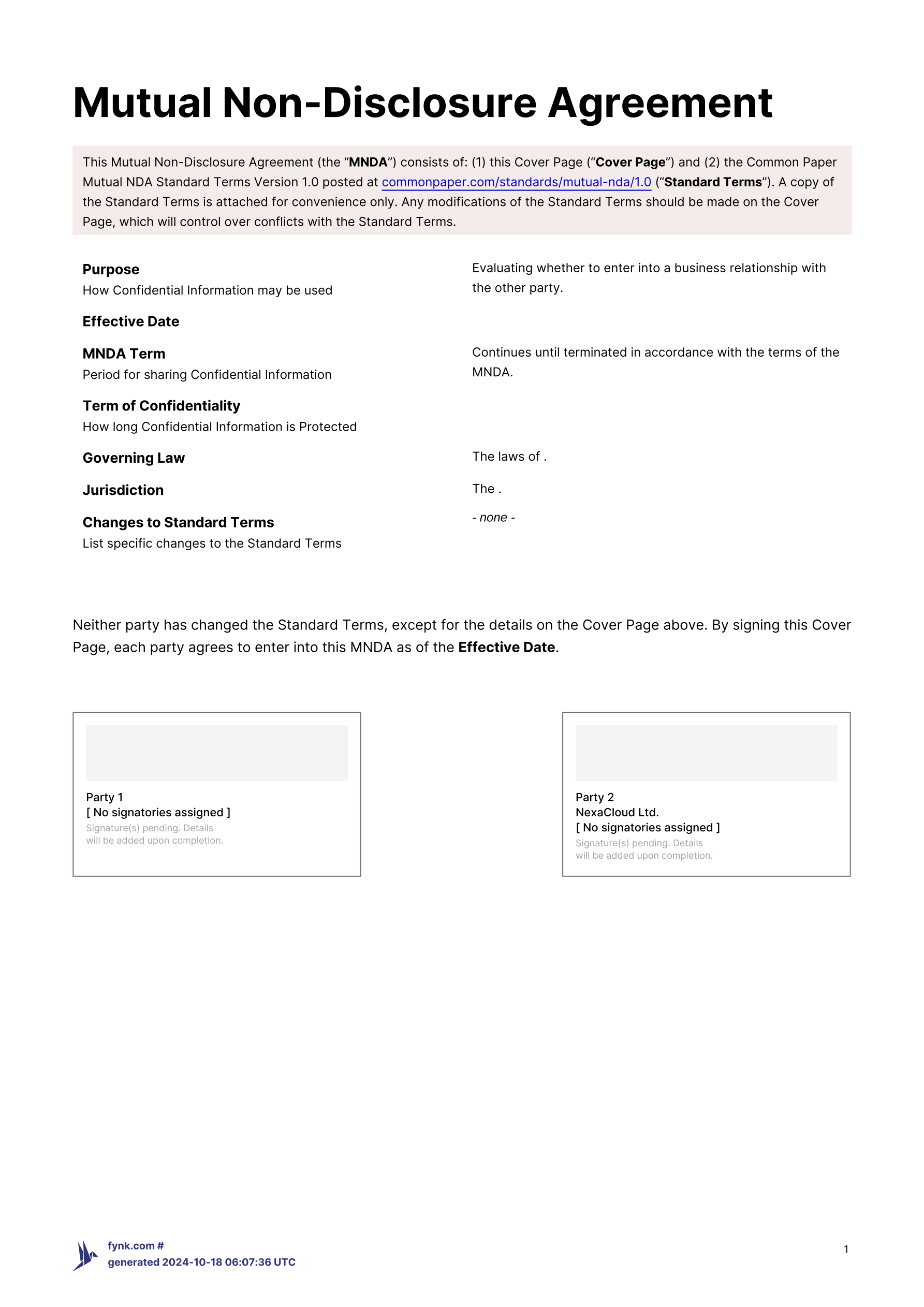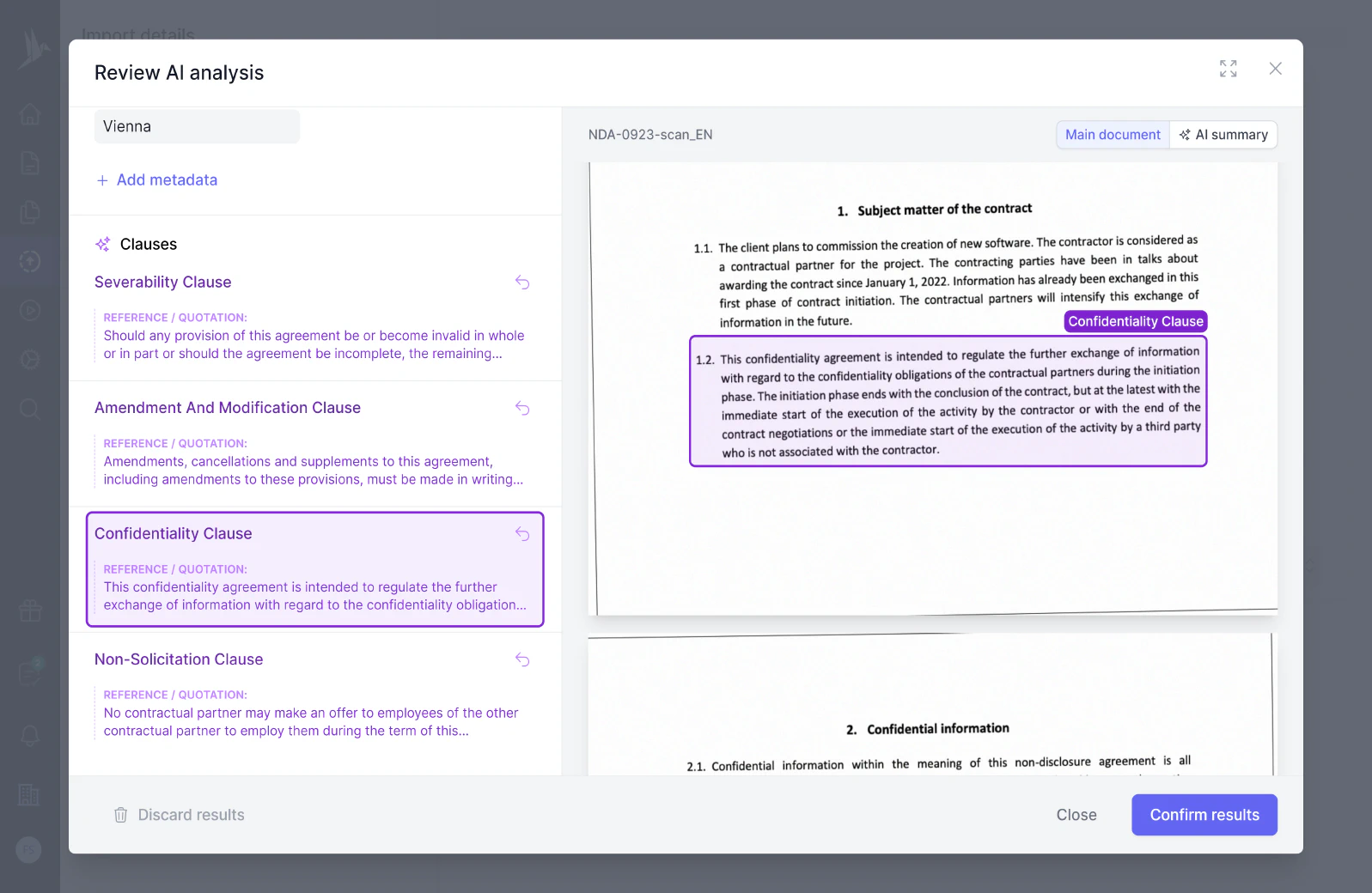
Mutual Non-Disclosure Agreement (NDA) Template
The Mutual Non-Disclosure Agreement (NDA) is a legal document that outlines the terms and conditions of a confidentiality agreement between two parties.
The "Duration of Confidentiality" clause specifies the time period during which parties involved are obligated to maintain the confidentiality of the disclosed information. This period may extend beyond the termination of the agreement, ensuring continued protection of proprietary information for a defined duration or indefinitely.
Duration of Confidentiality Obligations. Employee understands and acknowledges that Employee’s obligations under this Agreement with regard to any particular Confidential Information shall commence immediately upon Employee first having access to such Confidential Information (whether before or after Employee begins employment by Company) and shall continue during and after Employee’s employment by Company until such time as such Confidential Information has become public knowledge or generally known in Company’s industry other than as a result of Employee’s breach of this Agreement or breach by those acting in concert with the Employee or on the Employee’s behalf.
Duration of Confidentiality Obligations. You understand and acknowledge that your obligations under your Confidentiality Agreement with regard to any particular Confidential Information continue during and after your employment by the Company until such time as such Confidential Information has become public knowledge other than as a result of your breach of this Agreement or breach by those acting in concert with you or on your behalf.
Duration of Confidentiality Obligation: Each Receiving Party shall maintain the confidentiality and refrain from use of the Confidential Information for a period of two years following the termination or expiration of this Agreement, unless a longer duration is stipulated by applicable law or agreed upon by both parties.
Duration of Confidentiality. Each Party shall, during the term of this Agreement and for a period of three (3) years after the termination hereof, protect the unauthorized use or distribution of Confidential Information and shall use at least the same degree of care to prevent the disclosure of Confidential Information as each Party uses to protect its own Confidential Information. Each Party agrees not to disclose or permit any third-party access to the Confidential Information, except as such disclosure or access is necessary to perform the Services and only then if the recipient of such Confidential Information is bound by confidentiality obligations at least as protective as those contained herein.
Duration of Confidentiality Obligation. The obligation to maintain the confidentiality of Confidential Information will expire at the earlier of the date when the information is no longer Confidential Information as defined in Paragraph 2.4 or five (5) years after the expiration or termination date of this CRADA. Collaborator may request an extension to this term when necessary to protect Confidential Information relating to products not yet commercialized.
Duration of Confidentiality Obligations. The obligation to maintain the confidentiality of Confidential Information will expire at the earlier of the date when the information is no longer Confidential Information as defined in Article 2 or [**] after the expiration or termination date of this CRADA. The Parties may negotiate a separate agreement at the end of this period to extend the confidentiality obligation for specific information. The Parties agree not to disclose CRADA Data and descriptions of CRADA Materials until they are made publicly available in accordance with this Article 4. This term does not apply to ISI, for which the obligation to maintain confidentiality will extend indefinitely, per Section 6.2.
Duration of Confidentiality Obligations. Notwithstanding the expiration or termination of this Agreement, the parties’ respective confidentiality obligations will continue in effect for [***] after the expiration or termination of this Agreement.
Duration of Confidentiality Obligations. Employee understands and acknowledges that Employee’s obligations under this Agreement with regard to any particular Confidential Information shall continue so long as the information protected remains confidential in nature, and for the maximum amount of time allowed under applicable law.
Duration of Confidentiality Obligations. Executive understands and acknowledges that Executive’s obligations under this Agreement regarding Confidential Information begin immediately and shall continue during and after the Employment until the Confidential Information has become public knowledge other than as a result of Executive’s breach of this Agreement or a breach by those acting in concert with Executive or on Executive’s behalf. Executive further understands and agrees that in order for the Company to protect its Confidential Information, the Company may at any time in its sole discretion, either with or without notice, audit and/or review files, materials and documents, computer hardware or software, email or voice message systems that are provided to, utilized by and/or created by Executive in the course of the performance of Executive’s duties under this Agreement (except where prohibited by law) and Executive should have no expectation of privacy with respect to the use of such systems.
Duration of Confidentiality Obligations. The obligations contained in this Clause 13 (Confidentiality) shall last for 3 years following termination of this Agreement or a person ceasing to be Party to this Agreement.
Confidentiality and Non-Disclosure. (with a duration of confidentiality and non-use obligations as appropriate that is no less than five years from the date of disclosure for advisors, consultants, clinicians, vendors, service providers and contractors).
The “Duration of Confidentiality” refers to the time period during which confidential information must be kept private as stipulated in a contract or agreement. This clause outlines how long the parties involved are obligated to maintain the confidentiality of the shared information after it has been disclosed. It plays a crucial role in protecting sensitive information from unauthorized access or disclosure.
You should use a “Duration of Confidentiality” clause in any agreement involving the exchange of sensitive or proprietary information. This is particularly important when:
When writing a “Duration of Confidentiality” clause, ensure that it clearly defines:
Example:
“The Receiving Party agrees to maintain the confidentiality of the Disclosing Party’s Proprietary Information for a period of five (5) years from the date of disclosure, unless such information becomes publicly available through no fault of the Receiving Party or as required by law.”
The “Duration of Confidentiality” clause is commonly found in various types of contracts and agreements, including but not limited to:
By properly utilizing and drafting a “Duration of Confidentiality” clause, parties can safeguard sensitive information and maintain trust in their business relationships.
These templates contain the clause you just read about.

The Mutual Non-Disclosure Agreement (NDA) is a legal document that outlines the terms and conditions of a confidentiality agreement between two parties.
Dive deeper into the world of clauses and learn more about these other clauses that are used in real contracts.
The Duty of Cooperation clause mandates that all parties involved in a contract must actively assist and work together to ensure the successful fulfillment of their contractual obligations. This includes sharing necessary information, communicating effectively, and not hindering each other's performance.
The duty to mitigate damages clause requires a party who has suffered a loss or injury to take reasonable steps to minimize the financial impact of that loss. Failure to mitigate can reduce the amount of compensation recoverable from the other party responsible for the breach or harm.
The early termination of services clause outlines the conditions under which parties can end their contractual agreement before the originally agreed-upon end date. It typically includes stipulations regarding notice periods, potential penalties or fees, and any rights or obligations that survive termination.
Try our AI contract analysis and extract important clauses and information from existing contracts.
< <
Fill out the form and we will get in touch with you to give you a personal, customized demo of fynk.
Greetings!
I'm Markus, co-founder of fynk. After you've submitted the form, I'll swiftly get in touch with you.
Also, right after you submit your details, you can pick a time that works best for you for our meeting.

